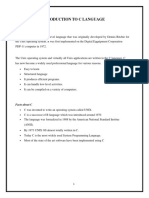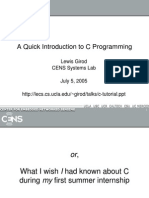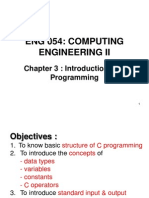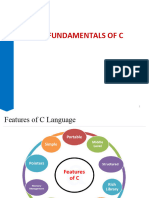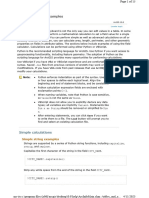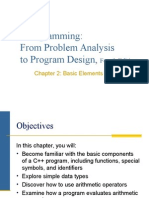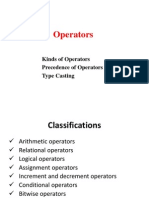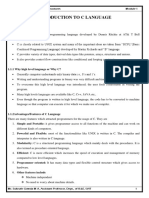C Programming Language
Uploaded by
KirkC Programming Language
Uploaded by
KirkC Programming Language
Slides by Russ hersberger based on N2454 draft of ISO/IEC
1
9899:202x
Basic C Program Files
• One or more text files
• Do not use a word processor.
• Use a basic text editor such as Notepad, Notepad++, Sublime Text, Visual Studio
Code, or many others that are available.
• File names:
• prog_name.c , the .c extension identifies the file as c language source code.
• header_name.h , the .h extension identifies the file a c language header.
• File names are generally lowercase with no spaces or other whitespace
characters.
• The underscore, considered a letter, is used to separate words in place of a
space.
Slides by Russ hersberger based on N2454 draft of ISO/IEC
2
9899:202x
C Header File Layout (*.h)
• Guard directives
• A set of directives:
• For including other files (usually header
files).
• Called text replacement macros.
• For conditionally controlling
preprocessing flow.
• Guard terminal directive
Slides by Russ hersberger based on N2454 draft of ISO/IEC
3
9899:202x
Basic C Source Code Files (*.c)
• Contain:
• A descriptive set of comments
• A sequence of preprocessing
directives for preparing the file for
compilation
• The sequence of C language
statements to be compiled
• One and only one file contains a
function named main that will be
called by the operating system.
Slides by Russ hersberger based on N2454 draft of ISO/IEC
4
9899:202x
Sample C Source File (demo.c)
Descriptive header section
Preprocessor Header section
The function main
C language statements Descriptive comment
Slides by Russ hersberger based on N2454 draft of ISO/IEC
5
9899:202x
Sample Header File (demo.h)
Descriptive header
Guard statements
to prevent multiple
inclusion
Macro to define a text
replacement for E_CHARGE
Guard terminator
Slides by Russ hersberger based on N2454 draft of ISO/IEC
6
9899:202x
Sample C program including local header
Descriptive header
Preprocessor Header section
that also includes local
header file demo.h
The identifier E_CHARGE
will be replaced by the
text 1.602176634e-16 by
the preprocessor before
compilation occurs.
Slides by Russ hersberger based on N2454 draft of ISO/IEC
7
9899:202x
Identifiers Clause 6.2.1
• Object
• Function
• Tag or a member of a structure, union, or enumeration
• Typedef name
• Label name
• Macro name
• Macro parameter.
Slides by Russ hersberger based on N2454 draft of ISO/IEC
8
9899:202x
Identifier Scope (Visibility) Clause 6.2.1
• Scope
• A region in a program where the identifier is visible.
• The meaning associated with an identifier can be used only within its scope.
• This means the same identifier can have different meanings for different
scopes.
• An out of scope identifier is invisible and cannot be used unless declared in
the local scope.
Slides by Russ hersberger based on N2454 draft of ISO/IEC
9
9899:202x
Scope regions Clause 6.2.1
• Four scope regions:
• File
• Identifier is not visible within other files in the same project
• Identifier is visible within the entire file even inside blocks
• Block
• A block is often identified by a pair of braces {}
• Identifiers declared within a block are invisible out side the block.
• Identifiers declared within a block override the file scope identifiers.
• Identifiers declared in a function definition’s parameter list have block scope of the associated
definition block.
• Function
• Only labels have function scope.
• They are implicitly declared when used.
• Function prototype (These have no associated definition block.)
• Identifiers declared in a function prototype’s parameter list become invisible at the end of the
prototype.
Slides by Russ hersberger based on N2454 draft of ISO/IEC
10
9899:202x
Object
• Clause 3.15: A region of data storage in the execution environment, the
contents of which can represent values.
• When referenced, an object may be interpreted as having a particular type
• Declaration of an object:
• Associates a type with a specified identifier.
• Definition of an object
• Allocates real memory (storage) to store value of the object.
• Assigns a sufficient number of bytes to accommodate the object’s type.
• Assigns a memory address to the object.
• Every byte in a computer’s memory has a unique address determined by
the memory system of the microprocessor when the computer is
constructed
Slides by Russ hersberger based on N2454 draft of ISO/IEC
11
9899:202x
Object Storage Lifetimes Clause 6.2.4
• Storage for objects may be returned to the memory pool once the
object is no longer needed.
• Some objects are stored in read-only memory and so they endure for
the life of the program.
• If an object is referred to outside of its lifetime, its behaviour is
undefined.
Slides by Russ hersberger based on N2454 draft of ISO/IEC
12
9899:202x
Four Kinds of Storage:
• Automatic (default)
• On demand. Volatile memory is allocated on demand for local variables, function parameters,
function return address etc.
• Memory is returned for re-allocation when no longer required. (Identifiers go out of scope).
• Usually allocated on a first-in-first-out memory structure called a stack.
• Static (use static keyword)
• Allocated for the duration of the program.
• Allocated from the same memory used for the program itself or from separate read only
memory. (Implementation defined)
• Its value is initialized only once prior to start-up.
• Thread (use _Thread-local keyword)
• Allocated for the duration of the thread execution.
• Its value is initialized prior to start up.
• Allocated
• Allocated on demand by using one of several allocation functions.
• The storage duration remains until de-allocated by the functions free() or realloc()
Slides by Russ hersberger based on N2454 draft of ISO/IEC
13
9899:202x
Types
• 6.2.5.1The meaning of a value stored in an object or returned by a
function is determined by the type of the expression used to access it.
• Function types
• Object types
• Can be complete (the storage size can be determined)
• Can be incomplete (the storage size can NOT be determined)
Slides by Russ hersberger based on N2454 draft of ISO/IEC
14
9899:202x
Object Character type
Variable declaration and definition
• The keyword without qualifiers implies a text based character
• The binary number is interpreted as an ASCII character
• Basic English (Latin) character set
• Character sets for other languages are available with Unicode
• Require a different type and more bytes
• Allocates 1 byte (8 bits) of storage.
• Using signed char or unsigned char qualifiers treat the variable as a 1-
byte signed or unsigned integer respectively not as a character.
Slides by Russ hersberger based on N2454 draft of ISO/IEC
15
9899:202x
Object Character Type
• Represents the Basic Execution Character set
• One byte of storage
• Use the reserved word char.
• Basic Execution Set
• ABCDEFGHIJKLMNOPQRSTUVWXYZ
• abc def g hIjk lmn o pqr s tu v wxy z
• 0123456789
• !”#% &‘()*+,-./:
• ;<=>?[\]^_{|}~
• The Unicode character set extends this concept to wide and multi-byte
characters
Slides by Russ hersberger based on N2454 draft of ISO/IEC
16
9899:202x
Character type example
• The first form declares, defines and assigns the character ‘H’ to c.
• The second form assigns a character ‘H’ to a previously defined c.
• A variable is defined when it is first assigned a value after its declaration.
• Assigning a value to an undeclared variable is a compiler error.
&c = 0x048abd64 1 bytes
• A variable that has a value assigned by the current program prior to first use is
called an initialized variable.
• It is best practice to always initialize variables.
Slides by Russ hersberger based on N2454 draft of ISO/IEC
17
9899:202x
Object Integer Types
• signed char – 8 bit signed integer
• unsigned char – 8 bit unsigned integer
• short, short int, signed, int, long int, long long, long long int
• Signed integer types
• Long long and long long int require the same storage space each and as much or
more than int
• signed and int require the same storage space each and as much or more than short
int
• The keywords signed and unsigned may also be applied to the types in the
second bullet as modifiers. Example signed short, or unsigned short, etc.
• As the name implies only integer (whole numbers) can be represented.s
Slides by Russ hersberger based on N2454 draft of ISO/IEC
18
9899:202x
Integer type example
Variable declaration and definition
• On a 32 bit processor:
• Allocates 4 bytes of storage at an address determined by the system.
• Assigns the symbol &a to represent
• The address 0x048abd65. The symbol, a, represents the contents at the address &a.
• The ampersand & is called the address-of operator in C
• Interprets the data contained within the 4 bytes as a signed integer.
&a = 0x048abd64 4 bytes
• Each rectangle represents 1 byte so can hold int numbers from -128 to +127. The data is
left over from previous assignments.
• The int value represented by a = -1711654075.
• This is called the uninitialized value of a. There is no guarantee of its value.
Slides by Russ hersberger based on N2454 draft of ISO/IEC
19
9899:202x
Integer type example
Variable declaration and definition
• The first form both declares, defines and assigns the value of 3 to a.
• The second form assigns a value of 3 to a previously defined a.
• A variable is defined when it is first assigned a value after its declaration.
• Defining an undeclared variable is a compiler error.
&a = 0x048abd64 4 bytes
• A variable that has a value assigned by the current program prior to first use is
called an initialized variable.
• It is best practice to always initialize variables.
Slides by Russ hersberger based on N2454 draft of ISO/IEC
20
9899:202x
Sample integer definitions with initialization
• The numeric literal 3 is assigned to each of
the defined variables at the right.
• The use of suffixes associates a data type
with each use of numeric literal 3.
• No suffix is used for char, short, and int
• U or U is used for unsigned literals
• L or l is used for long literals
• LL or ll is used for long long literals
• U and L may be combined in any order
• The suffixes may be uppercase or
lowercase.
• The objects are declared and defined at
the same time.
Slides by Russ hersberger based on N2454 draft of ISO/IEC
21
9899:202x
Object Floating Point Types <float.h>
• Floating point refers to a number representation similar to scientific
notation but adapted to restricted storage space and to allow efficient
arithmetic. IEEE-754.
• Standard floating types:
• float, double, long double.
• Decimal floating types:
• _Decimal32, _Decimal64, and _Decimal128.
• These are called the real floating types.
• All are signed types that allow fractional representation of quantites
Slides by Russ hersberger based on N2454 draft of ISO/IEC
22
9899:202x
Sample float definitions with initialization
• The numeric literal 3.0 is assigned to each
of the declared variables at the right.
• The use of suffixes associates a data type
with each use of numeric literal 3.0.
• F or f is used for float literals.
• No suffix is used for double float literals
• L or l is used for long double float literals
• The _Decimalx types are not supported in our
environment
• The objects are declared and defined at
the same time.
Slides by Russ hersberger based on N2454 draft of ISO/IEC
23
9899:202x
Object Complex Types <complex.h>
• Represent the real and imaginary parts of complex quantities.
• Storage as if a 2-element numeric array.
• All complex types are floating types.
• float _Complex have float storage size.
• _Complex have double storage size.
• double _Complex have long double storage size.
• Must include <complex.h>
Slides by Russ hersberger based on N2454 draft of ISO/IEC
24
9899:202x
Object type bool <stdbool.h>
• Two values:
• true
• false
• The header file defines:
• false = 0
• true = 1
• Allocates storage of at least 1 bit.
Slides by Russ hersberger based on N2454 draft of ISO/IEC
25
9899:202x
Object type Pointer
• The identifier (letter) a represents the address of a storage location.
• The addressing of a variable is also called referring to or referencing a
variable
• The asterisk (in this context) is called the dereferencing operator.
• It means the contents of the storage location that the address is referring to.
• The act of referencing is called pointing.
• The identifier that does the pointing is called a pointer.
• The letter sequence *a:
• Declares the letter “a” to be a pointer.
• Means the contents of the location referred to by a.
Slides by Russ hersberger based on N2454 draft of ISO/IEC
26
9899:202x
Object type Pointer examples
• The complete declaration also specifies
the data type of the contents stored at the
address
• The contents at address x is of type bool.
• The contents at address y is of type char.
• And so on.
• The following phrases are equivalent.
• The identifier x points to a value of type bool.
• “y points to int” is a shortened form.
• And so on
Slides by Russ hersberger based on N2454 draft of ISO/IEC
27
9899:202x
Selection Statement: IF
Single line
• The expression evaluates to
either: Block style
•0
• Not 0
• The statement is executed if the
expression is unequal to 0.
• The statement is not executed for
expression equal to 0.
• Expression type is any arithmetic
type, including but not necessarily
bool.
Slides by Russ hersberger based on N2454 draft of ISO/IEC
28
9899:202x
Selection Statement: If-Else Single line
• If expression is unequal to 0
• Statement 1 is executed Block style
• Statement 2 is not executed
• If expression is equal to 0
• Statement 2 is executed
• Statement 1 is not executed
• The block containing statement2 is
associated with the else keyword
Slides by Russ hersberger based on N2454 draft of ISO/IEC
29
9899:202x
Selection Statement: If-Else-if
• There is no elseif keyword in C
• It is a way of selecting one of several choices.
• The second if statement is executed if
expression1 equals 0
• The statement2 is executed only if
expression2 is unequal to zero.
• The block containing statement2 is
associated with the second if keyword, not
the else keyword
Slides by Russ hersberger based on N2454 draft of ISO/IEC
30
9899:202x
You might also like
- SINUMERIK 840D SL NC Variable and Interface SignalsNo ratings yetSINUMERIK 840D SL NC Variable and Interface Signals738 pages
- Advanced C Programming: Declarations, External Names, Memory LayoutNo ratings yetAdvanced C Programming: Declarations, External Names, Memory Layout32 pages
- A Quick Introduction To C Programming: Lewis Girod CENS Systems Lab July 5, 2005No ratings yetA Quick Introduction To C Programming: Lewis Girod CENS Systems Lab July 5, 200542 pages
- A Quick Introduction To C Programming: Lewis Girod CENS Systems Lab July 5, 2005No ratings yetA Quick Introduction To C Programming: Lewis Girod CENS Systems Lab July 5, 200542 pages
- Computer Reduced Syllabus Sindh Board SolvedNo ratings yetComputer Reduced Syllabus Sindh Board Solved27 pages
- Introduction To C Programming - PowerPoint SlidesNo ratings yetIntroduction To C Programming - PowerPoint Slides3 pages
- Institute For Advanced Computing and Software Development (Iacsd), AkurdiNo ratings yetInstitute For Advanced Computing and Software Development (Iacsd), Akurdi40 pages
- C++ From Beginner to Professional by Example (1)No ratings yetC++ From Beginner to Professional by Example (1)410 pages
- Computer Programming I: Grammar and Basic Elements of C Language Year 2020-2021No ratings yetComputer Programming I: Grammar and Basic Elements of C Language Year 2020-202146 pages
- Language Reference: IBM XL C Enterprise Edition V8.0 For AIXNo ratings yetLanguage Reference: IBM XL C Enterprise Edition V8.0 For AIX226 pages
- Question Bank For Avionics - V&V - Engineer PositionNo ratings yetQuestion Bank For Avionics - V&V - Engineer Position112 pages
- History of C Programming Language: Dennis RitchieNo ratings yetHistory of C Programming Language: Dennis Ritchie13 pages
- Structure of This Course: 1. Types - Variables - Expressions & StatementsNo ratings yetStructure of This Course: 1. Types - Variables - Expressions & Statements45 pages
- C# 7 and .NET Core: Modern Cross-Platform Development - Second EditionFrom EverandC# 7 and .NET Core: Modern Cross-Platform Development - Second Edition4.5/5 (2)
- Docker: The Complete Guide to the Most Widely Used Virtualization Technology. Create Containers and Deploy them to Production Safely and Securely.: Docker & Kubernetes, #1From EverandDocker: The Complete Guide to the Most Widely Used Virtualization Technology. Create Containers and Deploy them to Production Safely and Securely.: Docker & Kubernetes, #1No ratings yet
- Software Containers: The Complete Guide to Virtualization Technology. Create, Use and Deploy Scalable Software with Docker and Kubernetes. Includes Docker and Kubernetes.From EverandSoftware Containers: The Complete Guide to Virtualization Technology. Create, Use and Deploy Scalable Software with Docker and Kubernetes. Includes Docker and Kubernetes.No ratings yet
- Docker Basics Explained Clearly: A Practical Guide with ExamplesFrom EverandDocker Basics Explained Clearly: A Practical Guide with ExamplesNo ratings yet
- 1 - DIGI-260 - Lab 07 - VHDL Stepper Motor Controller - Rev 02No ratings yet1 - DIGI-260 - Lab 07 - VHDL Stepper Motor Controller - Rev 022 pages
- ELTR 270 - Diode Practice Problems and Solutions100% (1)ELTR 270 - Diode Practice Problems and Solutions33 pages
- ELTR 270 - Solutions - Practice Problems - First Order FiltersNo ratings yetELTR 270 - Solutions - Practice Problems - First Order Filters18 pages
- HREL 250 Module 3 - Template Report Registry For Widgets R Us IncNo ratings yetHREL 250 Module 3 - Template Report Registry For Widgets R Us Inc17 pages
- DIGI-260 - Lab 08 - Digital-to-Analog Conversion - Rev 04No ratings yetDIGI-260 - Lab 08 - Digital-to-Analog Conversion - Rev 0415 pages
- Stata User Guide Release 18 - Data Management, GenerateNo ratings yetStata User Guide Release 18 - Data Management, Generate6 pages
- Tib 661 GB 0319 T Sense Valid For T Sense Serial Numbers 131204 and HigherNo ratings yetTib 661 GB 0319 T Sense Valid For T Sense Serial Numbers 131204 and Higher46 pages
- C++ Programming: From Problem Analysis To Program Design,: Fourth EditionNo ratings yetC++ Programming: From Problem Analysis To Program Design,: Fourth Edition78 pages
- SDF I - Lecture 4 Variables Keywords DatatypesNo ratings yetSDF I - Lecture 4 Variables Keywords Datatypes39 pages
- C Language Made Easy For All 1st Edition Dr Sangram Patil pdf downloadNo ratings yetC Language Made Easy For All 1st Edition Dr Sangram Patil pdf download84 pages
- UNIT-1: Introduction To Computer OrganizationNo ratings yetUNIT-1: Introduction To Computer Organization51 pages









